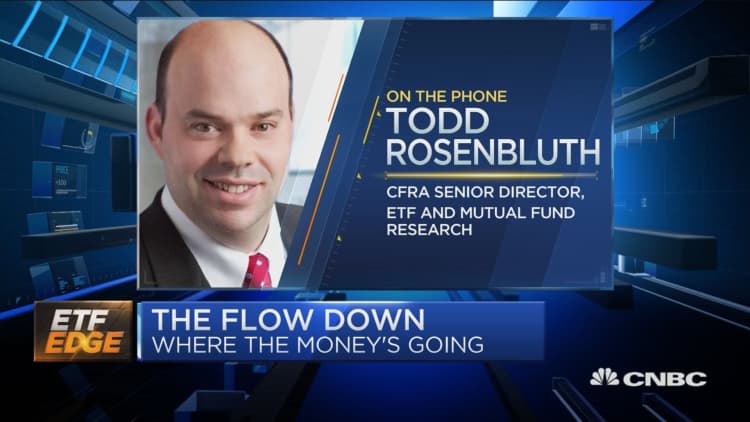
The second half of the year could be pivotal for the exchange-traded fund space.
Over $200 billion flowed into ETFs in the first half of 2020 despite stocks' plunge into a bear market and the frequent volatility spikes, according to CFRA Research.
That's enough to put the industry on track for a banner year, Todd Rosenbluth, senior director of ETF and mutual fund research at CFRA, told CNBC's "ETF Edge" on Monday.
"If people who found ETFs during the market volatility continue to embrace them, retail and institutional investors, we think we're going to challenge the record year of a couple years ago," he said, referring to 2018's $476 billion haul.
Last year was the second-best on record for ETF inflows, with a grand total of $326 billion.
This year, "investors rotated towards fixed-income ETFs … like LQD and HYG, getting corporate exposure" as the Federal Reserve vowed to buy up corporate bond assets to support the market, Rosenbluth said.
"They moved into gold products like GLD," or SPDR Gold Shares, the largest gold-backed ETF on the market, he said.
Rosenbluth also saw some money going into international ETFs, particularly low-cost products such as JPMorgan's Beta Builders Japan ETF (BBJP)."We think we're going to see continued growth," he said. "We could actually get closer to a record year in 2020 for ETF flows."
Bryon Lake, head of Americas ETF distribution at J.P. Morgan Asset Management, said investors looking to adjust their portfolios for the second half should take note of one key factor.
"We know that we need to stay invested in equities. We've certainly seen a huge rally off the bottom. But how do we do that in a way that's thoughtful and articulates the view that we want to take on markets?" Lake said in the same "ETF Edge" interview.
"Quality's a great way to do that," he said. "It helps you identify the strongest balance sheets of companies that are going to benefit and hopefully come out of this as winners in the long run."
Lake recommended his firm's U.S. Quality Factor ETF (JQUA), a collection of 238 stocks of large-cap companies that's down just over 3% year to date. Its holdings are ranked based on three "key quality pillars," according to J.P. Morgan: profitability, financial risk and earnings quality.
"Often times, investors will look at dividends for [quality], but with all the dividend announcements that we're seeing come through, we think that that space is going to be challenged," Lake said.
"When you can use an ETF like JQUA ... to help you identify the 100 strongest balance sheets that go across tech, energy and other areas, that certainly helps you to tilt your portfolios toward some of those names that could benefit in the long run," he said.
JQUA closed more than 1% higher on Tuesday. As of Monday, its sector exposure breakdown was roughly 27% technology, 16% financials, 14% consumer services, 14% health care, 11% industrials, 8% consumer goods, 3% utilities, 3% oil and gas, 2% basic materials and 2% communications.





